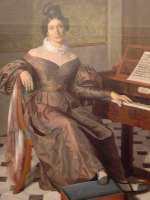Early Victorian fashion
 The term "Victorian fashion" refers to fashion in clothing in the Victorian era, or the reign of Queen Victoria (1837–1901). It is strictly used only with regard to the United Kingdom and its colonies, but is often used loosely to refer to Western fashions of the period. It may also refer to a supposedly unified style in clothing, home décor, manners, and morals, or a culture, said to be prevalent in the West during this period.
The term "Victorian fashion" refers to fashion in clothing in the Victorian era, or the reign of Queen Victoria (1837–1901). It is strictly used only with regard to the United Kingdom and its colonies, but is often used loosely to refer to Western fashions of the period. It may also refer to a supposedly unified style in clothing, home décor, manners, and morals, or a culture, said to be prevalent in the West during this period.Stylistically though not politically, the era begins around 1830 when there was a drastic change in fashion. After a revolution and the Napoleonic wars, a peaceful life with the family was what everybody wished for. At the same time, the beginning Industrial Revolution created a new upper class - not nobility t
 his time, but rich citizens, known by the French term bourgeoisie.
his time, but rich citizens, known by the French term bourgeoisie.Their ideals and status symbols, as it turned out, continued into the 20th century. They wanted to differentiate themselves from the old upper class, the nobility, by showing that they had earned their money. The men, therefore, turned to darker and duller clothing which did not vary much during the course of the century, emphasising how very serious, industrious and buinesslike they were. Breeches had vanished completely from a gentleman's wardrobe, to be replaced by tight, straight, more than ankle-length trousers. With it went a tailcoat, a carefully knotted necktie and a top hat.
Women on the other hand were allowed, nay required to display splendour to show that their husband could "afford her". The waist dropped to almost its natural level and was m
 ade to appear tiny not only by corsets, which saw a come-back, but also by exaggerated width both below and above. The shoulders were overemphasised by pulling the shoulder straps of the bodice as far outwards as they would go, resulting in a largely horizontal neckline, and optically extending them even further by adding huge, puffed sleeves. At the height of the "leg o'mutton" sleeve fashion, they had to be stiffened with whalebone. Hairstyles were also extreme: artfully braided, laid into corkscrew locks that hung in front of the ears, pinned up into buns that sat on top of the head like mushrooms. Outside, poke bonnets obstructed the sideways view.
ade to appear tiny not only by corsets, which saw a come-back, but also by exaggerated width both below and above. The shoulders were overemphasised by pulling the shoulder straps of the bodice as far outwards as they would go, resulting in a largely horizontal neckline, and optically extending them even further by adding huge, puffed sleeves. At the height of the "leg o'mutton" sleeve fashion, they had to be stiffened with whalebone. Hairstyles were also extreme: artfully braided, laid into corkscrew locks that hung in front of the ears, pinned up into buns that sat on top of the head like mushrooms. Outside, poke bonnets obstructed the sideways view.Thanks to
Mauritia.de

0 Comments:
Post a Comment
<< Home